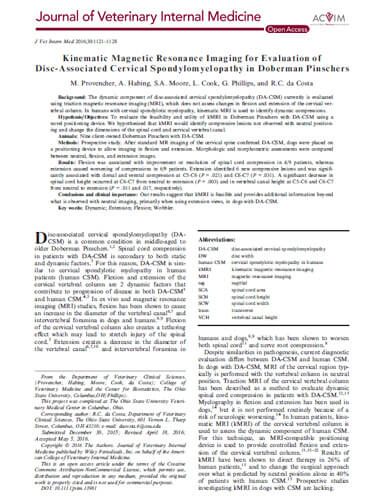Kinematic magnetic resonance imaging for evaluation of disc-associated cervical spondylomyelopathy in Doberman Pinschers. Journal of Veterinary Internal Medicine (2016)
Provencher M, Habing A, Moore SA, Cook LC, Phillips G, da Costa RC. Kinematic magnetic resonance imaging for evaluation of disc-associated cervical spondylomyelopathy in Doberman Pinschers. Journal of Veterinary Internal Medicine. v. 30, n.4, 1121-1128, 2016.
Informações do Artigo
Disponível em: Inglês
Total de Páginas: 8
Prévia
Disc-associated cervical spondylomyelopathy (DACSM) is a common condition in middle-aged to older Doberman Pinschers. Spinal cord compression in patients with DA-CSM is secondary to both static and dynamic factors. For this reason, DA-CSM is similar to cervical spondylotic myelopathy in human patients (human CSM). Flexion and extension of the cervical vertebral column are 2 dynamic factors that contribute to progression of disease in both DA-CSM and human CSM. In ex vivo and magnetic resonance imaging (MRI) studies, flexion has been shown to cause an increase in the diameter of the vertebral canal and intervertebral foramina in dogs and humans. Flexion of the cervical vertebral column also creates a tethering effect which may lead to stretch injury of the spinal cord. Extension creates a decrease in the diameter of the vertebral canal and intervertebral foramina in humans and dogs, which has been shown to worsen both spinal cord and nerve root compression.
Últimos Artigos
Chiari-like malformation in Cavalier King Charles Spaniels impacts brainstem auditory-evoked response latency results
Prognostic factors in acute intervertebral disc herniation. Frontiers in Veterinary Science. (2020)
Diagnostic imaging in intervertebral disc disease. Frontiers in Veterinary Science.(2020)
Classification of Intervertebral Disc Disease (2020)
Clinical Trial Design – A Review – With Emphasis on Acute Intervertebral Disc Herniation (2020)
Depoimentos
Ter acesso no nosso país a um curso ministrado em português por um professor de uma universidade americana, diplomado pelo ACVIM e com tamanha experiência em neurologia, sem dúvida alguma é um privilégio!!! Só tenho a agradecer!!
Gláucia de Oliveira Morato
MV, MSc, PhD - Clínica Veterinária Dr. PetItabira, MG.
Os dois cursos que pude participar foram de excelente qualidade! O conteúdo sempre atualizado e apresentado de maneira muito didática pelo Dr. Ronaldo, e acompanhada de casos clínicos muito esclarecedores. Agradeço muito a oportunidade!
Beatriz Kosachenco, MV, MSc
Professora de Cirurgia Veterinária, ULBRA/RS Porto Alegre, RSUm curso de aprendizagem prático e dinâmico! Como se estivesse nos EUA e convivendo no hospital de Ohio, mas o melhor que com realidade brasileira.
Agradecimento pela troca de informações e aprendizado.
Claudia Escalhão, MV, MSc, Dr
Rio de Janeiro, RJJá fiz cursos excelentes (tanto nacionais quanto internacionais), mas o do professor Ronaldo é excepcional e sem exagero algum, foi o melhor curso que já fiz em toda minha vida como médica veterinária. Avalio isso devido a didática que ele tem e a qualidade do curso. Foi uma semana de intensivão de neuro, onde nunca vi tamanha dedicação de um professor junto aos seus alunos. É um mestre!
Thamires Zanolini
Curitiba, PRO curso é extremamente completo e o Prof. Ronaldo se preocupa bastante em passar informações atualizadas. Apesar de serem assuntos extensos, com as aulas do curso é possível entender bem um pouco de tudo. É um ótimo ponto de partida para quem quer entrar na área da neuro (eu diria até indispensável!), e uma ótima base para quem quer agregar conhecimentos aos atendimentos de clínica ou reabilitação. Recomendo!
Raíza Von Ruthofer
São Paulo, SPO curso do Dr Ronaldo Casimiro é um divisor de águas. Mostrando de forma simples e prática a neurologia da clínica. Abordando o caminhar até o melhor exame complementar.
Rildo Siqueira
Pernambuco, PEAprendi com o Prof Ronaldo a realizar exame neurológico "clean", com metodologia e passo a passo! Pude aplicar de imediato no dia a dia de atendimentos, no ensino tanto de graduandos, residentes a pós-graduandos! de uma nota 0 a 1000- o curso foi nota 1000.
Ayne Murata Hayashi, MV, MSc.
Universidade de São Paulo, USP São Paulo, SPSensacional! Importante tanto para quem está começando e se interessa pela neurologia, como para quem já trabalha na área. Todo esse conhecimento compartilhado pelo papa da neuro e exemplificado com vídeos além da aula prática, foram uma oportunidade incrível!
Adriana Bernates
Rio de Janeiro, RJCurso de alta complexidade, porém com ótima didática. Escolha dos conteúdos e abordagens de muito bem embasadas com formas de avaliação e tratamentos utilizados em centros de referência, mas também proporciona alternativas levando-se em conta a realidade de cada um. Experiência incrível e de muito aprendizado!
